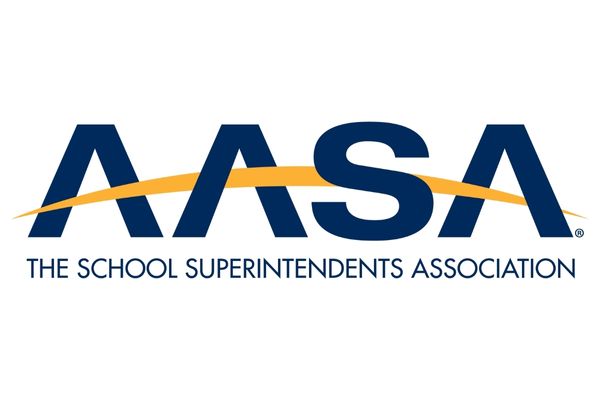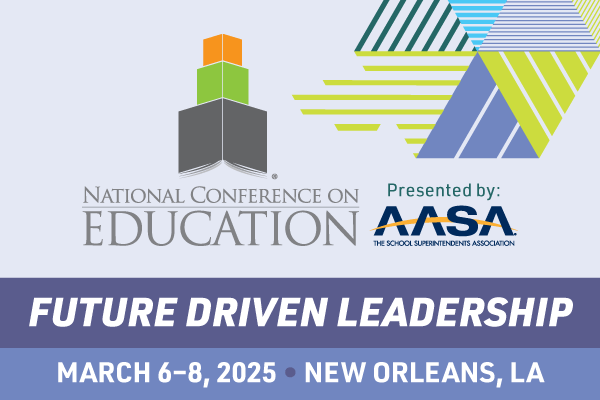AASA Report Calls for Multi-Year Plan for School Redesign, Addressing the Needs of Learners, Families, Communities
April 08, 2021
FOR IMMEDIATE RELEASE
Contact:
James Minichello
703-875-0723
703-774-6953 (cell)
jminichello@aasa.org
Report Identifies Core Essential Areas for Systemic Redesign
Alexandria, Va. – April 8, 2021 – A report released today by AASA, The School Superintendents Association, is recommending a holistic redesign of our nation’s schools aimed at capturing a new vision of future-focused, rigorous, energetic and culturally-vibrant learning through the empowerment of districts to enact change on behalf of learners, families and communities.
The report, An American Imperative: A New Vision of Public Schools was created by Learning 2025: A National Commission on Student-Centered Equity-Focused Education, a cadre of thought leaders in education, business, community and philanthropy, launched earlier this year by AASA.
“Returning to the past following the end of this pandemic is not an option for our schools,” said Daniel A. Domenech, executive director, AASA, and co-chair of the commission. “What makes this report stand out and what gives us hope is that it will impact practice at the classroom and school levels. It’s a call to action comprised of recommendations, coupled with specific action steps. Everyone associated with a school district—superintendents, principals, teachers, school boards, parents, and community and business leaders—must take bold steps to work together as systems on behalf of the well-being, self-sufficiency and success of our students.”
The report outlines critical functions—leading, teaching and learning—for realizing systemic change. “If we are to deliver learner-centered, equity-focused education to all learners, then we must experience a paradigm shift in how these positions function,” said Kristi Wilson, 2020-21 president of AASA and superintendent, Buckeye Elementary School District, Buckeye, Ariz. “As a commission, we believe that the ‘one-size-fits-all’ approach must no longer be tolerated. Now is the time to raise the voices of our superintendents on behalf of the students they serve.”
“We have an opportunity to finally bring our schools into the future and transform them into nimble systems,” said Bill Daggett, founder of the Successful Practices Network and co-chair of the commission. “Our recommendations can lead to personalized and customized instruction, and restore dignity and honor to teachers and the joys of learning.”
The reports affirms that leaders, teachers and learners play a role in redesigning systems, reengineering instruction and co-authoring the learning journey. Further, core component areas are essential and must be present to address any school system and community to meet the commission’s vision. These core areas include resources; culture; and social, emotional and cognitive growth.
AASA, in partnership with other national collaborative organizations, will identify demonstration school districts, a collection of forward-leaning urban, suburban and rural districts that exemplify the actions expressed in the report to serve as national models. Districts will be divided into different phases—Lighthouse, Aspiring and Emerging—to indicate various levels of development or implementation, and will help guide practical application, linked together through a series of virtual forums to share success stories and solve problems of practice. Each demonstration site will be the subject of a case study designed to guide schools, districts and regions in realizing the vision articulated in the commission’s recommendations. Policy support from local, state and national leaders will be integral to the overall effectiveness and success set forth by the report’s vision.
The report concludes with a series of appendices further explaining critical themes to amplify the commission’s vision for systemic redesign. Attached to each appendix is a specific set of action steps school system leaders are encouraged to implement to successfully redesign their schools. Appendices include:
- Whole Learner Framework and Design
- No Learner Marginalized
- Future Driven
- Learners as Co-Authors of Their Learning Journey
- Growth Model
- Learning Accelerator
- High Quality Early Learning for All Learners
- Diverse Educator Pipeline
- “Portraits Of”
The multi-year transition plan provides guardrails for change and simultaneous calls for the empowerment of districts and schools to enact change in ways best suited to their unique circumstances. “We, as a nation, are painfully divided and face a series of existential and systemic crises,” states the report. “The COVID-19 pandemic laid bare profound issues that we have known about for decades but have addressed with only minimal success. Confronting and overcoming long-brewing racial, economic and social injustices and disparities so that we may promote and safeguard healthy civic participation for all is the imperative of our day.”
To access An American Imperative: A New Vision of Public Schools, visit the AASA website. For additional information about the report or the Learning 2025: A National Commission on Student-Centered, Equity-Focused Education, contact Mort Sherman, AASA associate executive director, Leadership Network, at msherman@aasa.org, or Valerie Truesdale, AASA assistant executive director, at vtruesdale@aasa.org.
(Read Dan’s column: “An AASA Commission Plots Path to Excellence” published in the April 2021 edition of AASA’s award-winning, School Administrator magazine.)
To join the conversation via Twitter, please access#Learning2025.
###
About AASA
AASA, The School Superintendents Association, founded in 1865, is the professional organization for more than 13,000 educational leaders in the United States and throughout the world. AASA’s mission is to support and develop effective school system leaders who are dedicated to equitable access for all students to the highest quality public education. For more information, visit www.aasa.org.



